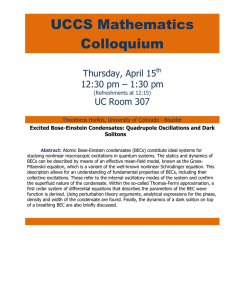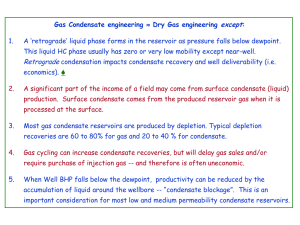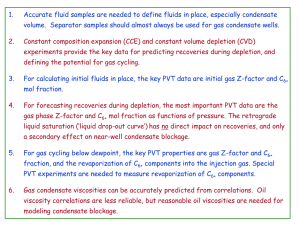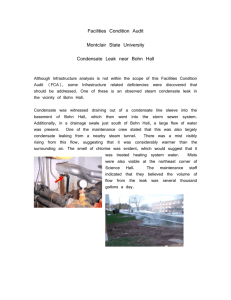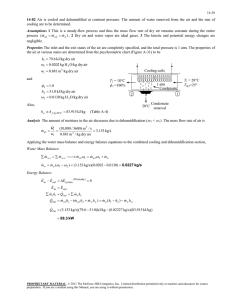Amplification of Local Instabilities in a Bose-Einstein Condensate with Attractive Interactions
advertisement
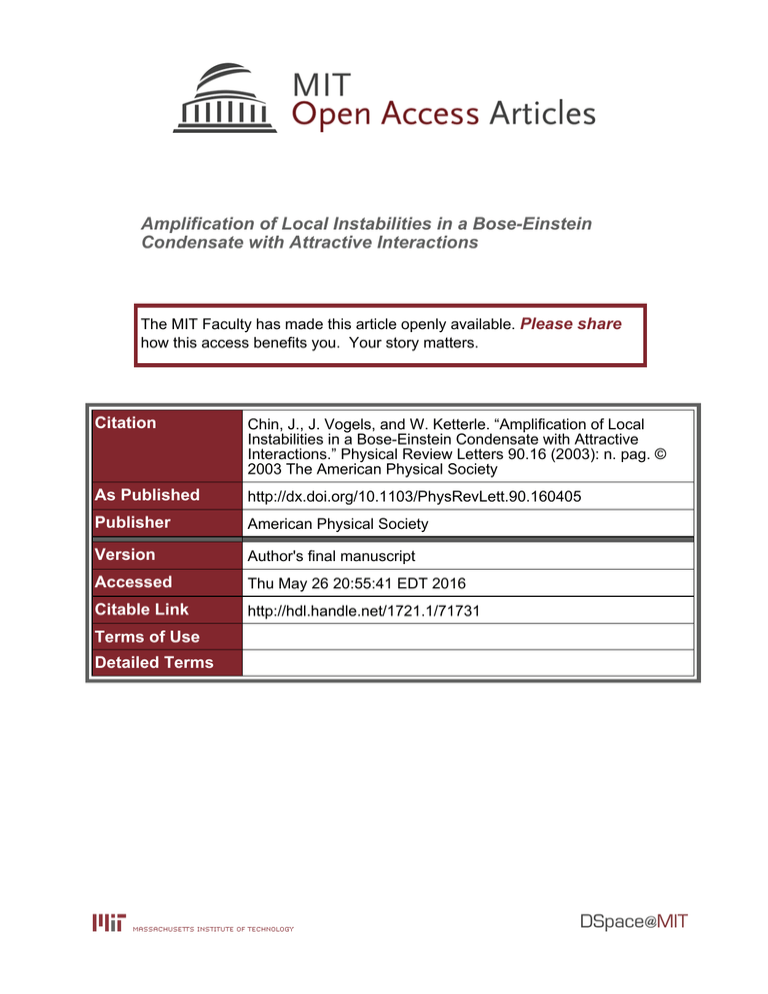
Amplification of Local Instabilities in a Bose-Einstein Condensate with Attractive Interactions The MIT Faculty has made this article openly available. Please share how this access benefits you. Your story matters. Citation Chin, J., J. Vogels, and W. Ketterle. “Amplification of Local Instabilities in a Bose-Einstein Condensate with Attractive Interactions.” Physical Review Letters 90.16 (2003): n. pag. © 2003 The American Physical Society As Published http://dx.doi.org/10.1103/PhysRevLett.90.160405 Publisher American Physical Society Version Author's final manuscript Accessed Thu May 26 20:55:41 EDT 2016 Citable Link http://hdl.handle.net/1721.1/71731 Terms of Use Detailed Terms VOLUME 90, N UMBER 16 week ending 25 APRIL 2003 PHYSICA L R EVIEW LET T ERS Amplification of Local Instabilities in a Bose-Einstein Condensate with Attractive Interactions J. K. Chin, J. M. Vogels,* and W. Ketterle† Department of Physics, MIT-Harvard Center for Ultracold Atoms, and Research Laboratory of Electronics, Massachusetts Institute of Technology, Cambridge, Massachusetts 02139 (Received 20 December 2002; published 24 April 2003) We study the collapse of large homogeneous Bose-Einstein condensates due to intrinsic attractive interactions. We observe the amplification of a local instability by seeding a momentum state p and suddenly switching the scattering length negative via a Feshbach resonance. We also observe the appearance of atoms in the conjugate momentum state as required by momentum conservation. For large condensates, the time scale for this depletion process becomes faster than that for global collapse. DOI: 10.1103/PhysRevLett.90.160405 PACS numbers: 03.75.Kk, 34.50.–s, 32.80.Pj turned off, so all subsequent dynamics are due only to the intrinsic attractive interactions. The resulting amplification and the associated generation of atoms in the conjugate momentum state verifies the theory. We end with a discussion on the different collapse time scales of competing processes and show that, for large condensates, this decay channel becomes dominant. The theoretical basis for the amplification of local instabilities is the dispersion relation for the elementary excitations in a Bose-Einstein condensate: s jpj2 jpj2 p ; (1) 2n0 U 2m 2m Our current understanding of the collapse of BoseEinstein condensates (BECs) with attractive interactions is incomplete. While the experiments in 7 Li provided many insights into the formation kinetics and stability [1], it was not until the discovery of externally induced Feshbach resonances [2] that it became possible to tune the value of the scattering length and study in detail the effects of an attractive mean field potential. This technique was used by Donley et al. to study 85 Rb with a negative scattering length, and they have observed rich dynamics inherent in the collapse of the condensate. Among the most intriguing observations were the formation of low energy ‘‘bursts’’ which were ejected out of the condensate [3]. While theoretically the enhancement of quantum fluctuations could give rise to such phenomena [4 –6], there is currently no consensus on the exact mechanism by which it occurs. Thus far, theoretical developments have been limited by having only one experimental testing ground. The experiments using 85 Rb were done using small condensates ( 15 000 atoms), where the attractive mean field energy is comparable to the h! level spacing of the harmonic trapping potential. In this paper, we study the collapse of large sodium condensates far in the ThomasFermi regime (jj h!), where the spatial profile of the condensate is relatively homogeneous. Much of the dynamics of such a system is then described by local phenomena. When the interactions become attractive, Yurovsky [5] predicts that local instabilities with momentum on the order of the (imaginary) speed of sound will undergo exponential growth. Simultaneously, momentum conservation requires atoms to be generated in conjugate momentum states. Since amplification happens on the time scale of the chemical potential h=, the resulting quantum evaporation of the zero momentum condensate atoms can happen faster than the global collapse where the whole condensate ‘‘implodes.’’ We probe for local instabilities by seeding a particular momentum state with an initial population, then suddenly switching the scattering length negative via a Feshbach resonance. At the same time, the trapping potential is where the growth rate p is given by jpj=h [Eq. (1)] when a < 0 [5] and p is the destruction operator for mode p. The instability of the mode pair (p, p) results in correlated growth, where the creation of an atom in the p state is accompanied by the creation of an atom in the p state. A similar phenomenon is also responsible for the four wave mixing process observed in [7,8]. At higher momentum, the energy becomes real again as the excitations now have enough kinetic energy to stabilize them against the attractive interactions. In our experiments, we created large cigar-shaped sodium condensates in the F 1, mF 1 spin state with typical atom numbers of 30 million and peak densities of 3 1014 cm3 in a Ioffe-Pritchard magnetic trap. Following this, they were adiabatically loaded into a mode-matched 1064 nm cylindrical optical dipole trap with trapping frequencies of 250 and 2 Hz and held for 1 s 160405-1 2003 The American Physical Society 0031-9007=03=90(16)=160405(4)$20.00 where n0 is the density, U 4 h 2 a=m =n0 is the contact potential, a is the scattering length, and m is the atomic mass. For an elementary excitation whose momentum satisfies jpj2 =2m < 2jj, an instability forms when < 0 (i.e., a < 0) and oscillatory behavior gives way to exponential growth or decay. A formal derivation gives the evolution of these low momentum modes as hyp p it jUn0 j2 sinh2 pt; h 2 2 p (2) 160405-1 VOLUME 90, N UMBER 16 PHYSICA L R EVIEW LET T ERS to allow transient excitations to damp out. In the next 117 ms, the axial magnetic field was ramped up to an intermediate value just short of the 1195 G Feshbach resonance [9]. Two pairs of coils coaxial with the condensates contributed to the bias field: The bias coils produced a large field of 1200 G and the pinch coils produced a small field of 8 G. Since their mutual inductance was small, the small pinch coils could be switched off suddenly to jump up the field in under 10 s with a negligible adverse effect on the bias field ( 1 G). By changing the intermediate field value, we were also able to tune the scattering length a continuously from the background scattering length a0 to zero to arbitrary negative values. The reproducibility of the resulting magnetic field was 0.4 G. At this point, the condensates were slightly compressed by a small axial magnetic field curvature, giving them radial and axial dimensions of 15 pm and 1.5 mm, respectively, and a speed of sound c Un0 =m of 8 mm=s. We imprinted a low momentum excitation onto a stable condensate (a > 0) using a two photon optical Bragg transition to couple atoms from the zero momentum state to a low momentum state p [10]. The Bragg beams were pulsed on for 400 s and were directed at an angle of 15 and 20 , respectively, from the long axis of the condensate, creating phonons propagating with a momentum of m 2:5 mm=s in a predominantly radial direction. With this momentum p, the minimum value of jaj required for amplification to happen is estimated to be 0:06 nm. The beams were red-detuned from the sodium D2 line by 3 nm to minimize Rayleigh scattering, and had a frequency difference of ! 2 700 Hz. At this point, we changed the scattering length a suddenly and entered the Feshbach resonance by turning off the pinch coils. This technique reduced the time available for three-body decay, thereby overcoming the problematic high loss rate first observed by Inouye et al. [2] and gave us a well-defined initial condition similar to that in [3]. At the same instant, we also turned off the optical trapping potential to allow the system to evolve under its intrinsic attractive interactions. After a variable time of 0 to 1 ms, the magnetic fields were switched off, causing the scattering length to become positive again. Following 6 ms of ballistic expansion, a pump pulse from F 1 to F0 2 was applied. Radial absorption images providing the momentum distribution of the condensates were taken on the F 2 to F0 3 cycling transition . The images in Fig. 1 probe the radial dynamics of the condensates and provide dramatic visual verification of quantum evaporation. Figure 1(a) shows the p excitations moving out of the condensate without any amplification. In contrast, Fig. 1(b) was taken after the condensate had been held at a 0:82 nm for 600 s. Not only was the number of atoms in the p momentum state significantly amplified, it was accompanied by the formation of excitations in the p momentum state, here 160405-2 week ending 25 APRIL 2003 FIG. 1. Amplification of unstable excitations in a BEC with a < 0. In (a), the unamplified p excitations are shown moving out of the condensate after 6 ms ballistic expansion. In (b), the p excitations have been amplified and are accompanied by the formation of p excitations after 600 s of hold time at a 0:82 nm. The field of view is 960 m by 100 m. The insets show a radial optical density profile in arbitrary units averaged over a 100 m long section of the condensate which was relatively uniform. seen moving out of the condensate in the opposite direction. These observations clearly demonstrate the instability of a condensate with negative scattering length. Because of the large aspect ratio of our condensates, only part of the condensate could be imaged at high magnification. However, since the p and p excitations were created predominantly in the radial direction, this was not a limitation. The small ‘‘kinks’’ that were also apparent in our condensate are most likely a result of imperfections in our optical dipole trap. Yet, rather than degrade the signal, they highlight the parallel contours between the condensate and the ridge of excitations as atoms move out with a definite momentum. In order to perform more quantitative tests of this phenomenon, we first characterized the negative scattering length dependence on the field by directly probing the strength of the attractive interactions. As before, optically trapped condensates close to a Feshbach resonance were prepared. The confining infrared laser beam was then replaced with a repulsive 3 nm blue-detuned ‘‘antitrap’’ beam as we simultaneously jumped to negative scattering lengths. At the right intensity I, the antitrap beam provided the correct amount of repulsive dipole force needed to compensate for the attractive interactions within the condensate and suppressed any global contraction of size. However, this is an unstable equilibrium and any sloshing of the condensate or misalignment of the laser beam caused the condensate to be repelled. Therefore the antitrap was fine aligned to milliradian accuracy such that a condensate with a > 0 was ripped apart radially into a hollow cylinder. Using this method, we were able to stabilize an attractive condensate for 0.2 to 2 ms, depending on aB, before unavoidable losses became significant. 160405-2 4 500 2 0 0 -2 Mode Population (a. u.) 6 a (nm) Light Intensity (a.u.) 0.010 8 1000 -500 1195 -4 1200 1205 week ending 25 APRIL 2003 PHYSICA L R EVIEW LET T ERS VOLUME 90, N UMBER 16 1210 1215 +p -p 0.005 0.000 1220 0 200 400 600 Magnetic Field (G) Time (µs) FIG. 2. Characterization of the Feshbach resonance. The light intensity needed to balance out the interatomic interactions gives the dependence of the scattering length on magnetic field. The solid line is a fit to the data. FIG. 3. Amplification of excitations in a BEC with a < 0. The growth of the normalized mode population in both p and p modes as a function of hold time at a 1:35 nm is fitted to an exponential dependence according to Eq. (2), which gave a common growth rate of 5:89 0:83 ms1 . A variable offset accounted for the initial seeding of the p mode. 160405-3 large error bars reflect the high sensitivity of the dynamics to the magnetic field. In particular, the inelastic loss rates as a function of a have not yet been well characterized, which limits the accuracy of our data. The results presented here prove conclusively that quantum evaporation is part of the complex dynamics that occur during the collapse of an attractive condensate. While we select a particular mode for observation, the effect is predicted to happen for all modes satisfying jpj2 =2m < 2jj. At short times, the pairwise emission of atoms also implies that the number of atoms in the conjugate mode pairs will be exactly correlated, although as the condensate becomes increasingly depleted, higher order effects will degrade the correlation [5]. Since quantum evaporation is intrinsic to the condensate, a natural question to ask is how large a part it plays in the unperturbed collapse of the condensate. From [5], the depletion of the condensate density n0 is given by 10 Growth Rate ( ms-1) The radial dimension was used to monitor the mechanical dynamics of the condensate occurring on the 250 Hz time scale of the trap frequency. For minimal distortion of the spatial image, absorption images were taken after only 2 ms of ballistic expansion necessary for the high magnetic fields to die out. In equilibrium, a / Fattractive Frepulsive / I, and we obtain the scattering length dependence on the magnetic field by plotting I vs B (Fig. 2). A red-detuned laser beam with a similar detuning of 3 nm was employed to obtain the points for positive a. By fitting the expected Feshbach curve aB a0 1 B=B B0 to our data, we find the width B of the resonance to be 2:4 0:4 G which determines the range of the magnetic field we have to work within [11]. Here, a0 3:3 nm is the triplet scattering length at high fields [12]. A quantitative analysis of the growth in the p and p modes was performed by monitoring their occupation number as a function of hold time in the attractive regime (Fig. 3). The number count per mode was normalized to the number of atoms in the condensate at the end of the hold time to account for the high loss of atoms during this process due to inelastic collisions [13]. The maximum duration of amplification was limited by the lifetime of the condensate, which was about 600 s for a 1:35 nm. Following Eq. (2), an exponential dependence was fitted to the data, yielding a common growth rate of 5:89 0:83 ms1 for both modes. This agrees well with the theoretical value of 5:57 ms1 , estimated using our initial mean field of h 5 kHz. We also investigated the dependence of the growth rate on the strength of the interactions. By varying the scattering length and extracting as above, we observed a strong increase of with jaj (Fig. 4). A fit to the p theoretical prediction p b1 jaj b2 [Eq. (1)] yielded the fit parameters b1 1:11 0:14 108 nm1=2 ms1 and b2 0:078 0:04 nm, in agreement with theoretical estimates of 1:55 108 nm1=2 ms1 and 0.06 nm, respectively. For this sequence of measurements, the initial mean field was h 4 kHz. The 8 6 4 2 0 0 1 2 3 |a| (nm) FIG. 4. Growth rate of excitations in a BEC with a < 0. The rate increases with the magnitude of the negative scattering length jaj. The solid line shows a best fit to the predicted p b1 jaj b2 dependence. 160405-3 r 2 h 2 2 n_ 0 4 a n0 exp8 hjajn 0 t=m: mt (3) Using our parameters, we extract the time t1=e taken for n0 to decay to 1=e of its original value and compare it to the observed time taken for the condensate to decay without initial seeding until it is no longer discernable (using a visibility threshold of about 10% to 20%) in Fig. 5. As both the number of unstable modes and the amplification rate increase with a, there is a significant decrease of t1=e with jaj. We also considered the effect of the initial quantum depletion ( 1%, [14]) on t1=e , but concluded that its impact is small. In addition, we compare the observed collapse time to the decay time predicted for global collapse. This implosion corresponds to the unstable monopole mode and may be qualitatively described by Eq. (1) if we assume a momentum equal to h times the inverse size of the condensate. However, the global collapse is more accurately described by accounting for the inhomogeneous spatial profile of the condensate. The inherent pressure gradient will cause the condensate to collapse inwards and the resulting compression causes the density to increase and sharply enhance the three-body recombination loss rate, which goes like n20 . We model the R radial evolution using the mean squared radius R r2 j rj2 r dr. For our cylindrical condensates with an aspect ratio of 100:1, an analytical solution for the resulting 2D dynamics exists [15,16], given by R& 4mE !2 R, where E is the total energy of the system. Since ! 0 and da dt 0 in our experiments, E is conserved and determined from initial conditions. The time taken to reach R 0 is r 1 a0 tdecay : (4) !0 jaj Equation (4) is also plotted in Fig. 5 and its intersection with t1=e separates the graph into two domains. For small jaj, global collapse is predicted to dominate over quantum evaporation while the converse is true at larger jaj. This is explained by noting that the decay of the condensate is dominated p by the amplification of unstable modes with pmax 2mjcj h=, where is the value of the (imaginary) healing length [Eq. (1)]. When is comparable to the condensate size, the local description is invalid and global collapse occurs. In the Thomas-Fermi limit, however, is small and local instabilities deplete the condensate much faster than global collapse. This is consistent with our observations in Fig. 5. We were unable to study the condensate lifetime at even more negative scattering lengths since the condensate then decayed almost instantaneously. To realize a global collapse time much slower than t1=e would require a combination of a weak trap with a high number of atoms, which is currently out of reach. In conclusion, we have shown that large condensates far in the Thomas-Fermi regime undergo amplification of 160405-4 week ending 25 APRIL 2003 PHYSICA L R EVIEW LET T ERS 4 Collapse Time (ms) VOLUME 90, N UMBER 16 2 0 0 1 2 3 4 5 Scattering Length (nm) FIG. 5. Time scales for BEC decay. The observed collapse time is compared to the time taken for the condensate density to fall to 1=e of its original value (t1=e ) due to instability amplification [solid curve, Eq. (3)] and the expected tdecay for global collapse [dashed curve, Eq. (4)]. local instabilities when their scattering length becomes negative. We have studied the dependence of amplification rate on the magnitude of the negative scattering length and found reasonable agreement with the theory. For our parameters, this quantum evaporation process becomes faster than the global collapse. We thank K. Xu, T. Mukaiyama, and J. R. Abo-Shaeer for experimental assistance, J. Anglin for valuable comments, and A. E. Leanhardt and Z. Hadzibabic for critical reading. This work was funded by ONR, NSF, ARO, NASA, and the David and Lucile Packard Foundation. *Present address: Laboratoire Kastler Brossel, ENS, Paris. † Group website: http://cua.mit.edu/ketterle_group/ [1] J. M. Gerton et al., Nature (London) 408, 692 (2000). [2] S. Inouye et al., Nature (London) 392, 151 (1998). [3] E. A. Donley et al., Nature (London) 412, 295 (2001). [4] R. A. Duine and H. T. C. Stoof, Phys. Rev. Lett. 86, 2204 (2001). [5] V. A. Yurovsky, Phys. Rev. A 65, 033605 (2002). [6] E. A. Calzetta and B. L. Hu, arXiv:cond-mat. [7] L. Deng et al., Nature (London) 398, 218 (1999). [8] J. M. Vogels et al., Phys. Rev. Lett. 89, 020401 (2002). [9] J. Stenger et al., Phys. Rev. Lett. 82, 2422 (1999). [10] J. Stenger et al., Phys. Rev. Lett. 82, 4569 (1999). [11] We observe the resonance around 1208 10 G, which agrees with the theoretical value within the systematic error of the magnetic field calibration which was done at low fields using rf spectroscopy. [12] C. Samuelis et al., Phys. Rev. A 63, 012710 (2000). [13] This is an approximation, since the loss rates for condensate and noncondensate atoms are different due to quantum statistics. [14] K. Huang, Statistical Mechanics (Wiley, New York, 1987). [15] Y. Kagan et al., Phys. Rev. A 54, R1753 (1996). [16] Y. Kagan et al., Phys. Rev. Lett. 79, 2604 (1997). 160405-4
